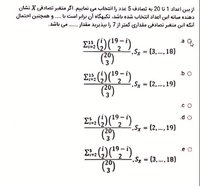Hey everyone. This problem was in my exam and I couldn't find my answer in multiple answer choices that were given. and I'm not sure if I'm doing it wrong or the choices were wrong.
From the numbers 1 to 20, we randomly select 5 numbers. If the random variable X represents the median of these selected numbers, what is the probability that this random variable will be less than 7?
I could really use some help. Thank you in advance. (On a side note, I don't speak English so I had to translate the problem. I hope it's still clear!)
From the numbers 1 to 20, we randomly select 5 numbers. If the random variable X represents the median of these selected numbers, what is the probability that this random variable will be less than 7?
I could really use some help. Thank you in advance. (On a side note, I don't speak English so I had to translate the problem. I hope it's still clear!)


